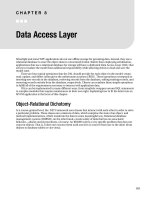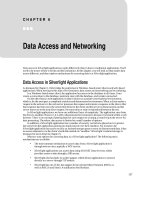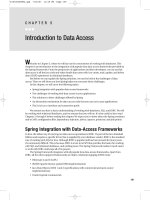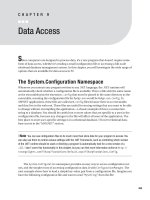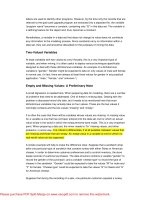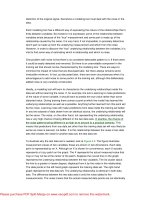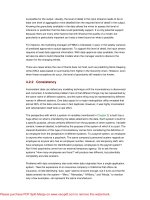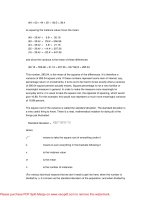Spring Data Modern Data Access for Enterprise Java pdf
Bạn đang xem bản rút gọn của tài liệu. Xem và tải ngay bản đầy đủ của tài liệu tại đây (11.07 MB, 314 trang )
Spring Data
Modern Data Access for Enterprise Java
Mark Pollack, Oliver Gierke, Thomas Risberg,
Jon Brisbin, and Michael Hunger
Beijing
•
Cambridge
•
Farnham
•
Köln
•
Sebastopol
•
Tokyo
Spring Data
by Mark Pollack, Oliver Gierke, Thomas Risberg, Jon Brisbin, and Michael Hunger
Copyright © 2013 Mark Pollack, Oliver Gierke, Thomas Risberg, Jonathan L. Brisbin, Michael Hunger.
All rights reserved.
Printed in the United States of America.
Published by O’Reilly Media, Inc., 1005 Gravenstein Highway North, Sebastopol, CA 95472.
O’Reilly books may be purchased for educational, business, or sales promotional use. Online editions
are also available for most titles (). For more information, contact our
corporate/institutional sales department: 800-998-9938 or
Editors: Mike Loukides and Meghan Blanchette
Production Editor: Kristen Borg
Proofreader: Rachel Monaghan
Indexer: Lucie Haskins
Cover Designer: Karen Montgomery
Interior Designer: David Futato
Illustrator: Rebecca Demarest
October 2012: First Edition.
Revision History for the First Edition:
2012-10-11 First release
See for release details.
Nutshell Handbook, the Nutshell Handbook logo, and the O’Reilly logo are registered trademarks of
O’Reilly Media, Inc. Spring Data, the image of a giant squirrel, and related trade dress are trademarks
of O’Reilly Media, Inc.
Many of the designations used by manufacturers and sellers to distinguish their products are claimed as
trademarks. Where those designations appear in this book, and O’Reilly Media, Inc., was aware of a
trademark claim, the designations have been printed in caps or initial caps.
While every precaution has been taken in the preparation of this book, the publisher and authors assume
no responsibility for errors or omissions, or for damages resulting from the use of the information con-
tained herein.
ISBN: 978-1-449-32395-0
[LSI]
1349968177
Thanks to my wife, Daniela, and sons, Gabriel
and Alexandre, whose patience with me stealing
time away for “the book” made it possible.
—Mark Pollack
I’d like to thank my family, friends, fellow musi-
cians, and everyone I’ve had the pleasure to work
with so far; the entire Spring Data and Spring-
Source team for this awesome journey; and last,
but actually first of all, Sabine, for her inexhaus-
tible love and support.
—Oliver Gierke
To my wife, Carol, and my son, Alex, thank you
for enriching my life and for all your support and
encouragement.
—Thomas Risberg
To my wife, Tisha; my sons, Jack, Ben, and Dan-
iel; and my daughters, Morgan and Hannah.
Thank you for your love, support, and patience.
All this wouldn’t be worth it without you.
—Jon Brisbin
My special thanks go to Rod and Emil for starting
the Spring Data project and to Oliver for making
it great. My family is always very supportive of
my crazy work; I’m very grateful to have such
understanding women around me.
—Michael Hunger
I’d like to thank my wife, Nanette, and my kids for
their support, patience, and understanding.
Thanks also to Rod and my colleagues on the
Spring Data team for making all of this possible.
—David Turanski
Table of Contents
Foreword .
. . . . . . . . . . . . . . . . . . . . . . . . . . . . . . . . . . . . . . . . . . . . . . . . . . . . . . . . . . . . . . . . . xiii
Preface . . . . . . . . . . . . . . . . . . . . . . . . . . . . . . . . . . . . . . . . . . . . . . . . . . . . . . . . . . . . . . . . . . . . . xv
Part I. Background
1. The Spring Data Project .
. . . . . . . . . . . . . . . . . . . . . . . . . . . . . . . . . . . . . . . . . . . . . . . . . 3
NoSQL Data Access for Spring Developers 3
General Themes 5
The Domain 6
The Sample Code 6
Importing the Source Code into Your IDE 7
2. Repositories: Convenient Data Access Layers . . . . . . . . . . . . . . . . . . . . . . . . . . . . . . . 13
Quick Start 13
Defining Query Methods 16
Query Lookup Strategies 16
Query Derivation 17
Pagination and Sorting 18
Defining Repositories 19
Fine-Tuning Repository Interfaces 20
Manually Implementing Repository Methods 21
IDE Integration 22
IntelliJ IDEA 24
3. Type-Safe Querying Using Querydsl .
. . . . . . . . . . . . . . . . . . . . . . . . . . . . . . . . . . . . . . 27
Introduction to Querydsl 27
Generating the Query Metamodel 30
Build System Integration 30
Supported Annotation Processors 31
vii
Querying Stores Using Querydsl 32
Integration with Spring Data Repositories 32
Executing Predicates 33
Manually Implementing Repositories 34
Part II. Relational Databases
4. JPA Repositories . . . . . . . . . . . . . . . . . . . . . . . . . . . . . . . . . . . . . . . . . . . . . . . . . . . . . . . 37
The Sample Project 37
The Traditional Approach 42
Bootstrapping the Sample Code 44
Using Spring Data Repositories 47
Transactionality 50
Repository Querydsl Integration 51
5. Type-Safe JDBC Programming with Querydsl SQL . . . . . . . . . . . . . . . . . . . . . . . . . . . . 53
The Sample Project and Setup 53
The HyperSQL Database 54
The SQL Module of Querydsl 54
Build System Integration 58
The Database Schema 59
The Domain Implementation of the Sample Project 60
The QueryDslJdbcTemplate 63
Executing Queries 64
The Beginning of the Repository Implementation 64
Querying for a Single Object 65
The OneToManyResultSetExtractor Abstract Class 67
The CustomerListExtractor Implementation 68
The Implementations for the RowMappers 69
Querying for a List of Objects 71
Insert, Update, and Delete Operations 71
Inserting with the SQLInsertClause 71
Updating with the SQLUpdateClause 72
Deleting Rows with the SQLDeleteClause 73
Part III. NoSQL
6. MongoDB: A Document Store .
. . . . . . . . . . . . . . . . . . . . . . . . . . . . . . . . . . . . . . . . . . . 77
MongoDB in a Nutshell 77
Setting Up MongoDB 78
Using the MongoDB Shell 79
viii | Table of Contents
The MongoDB Java Driver 80
Setting Up the Infrastructure Using the Spring Namespace 81
The Mapping Subsystem 83
The Domain Model 83
Setting Up the Mapping Infrastructure 89
Indexing 91
Customizing Conversion 91
MongoTemplate 94
Mongo Repositories 96
Infrastructure Setup 96
Repositories in Detail 97
Mongo Querydsl Integration 99
7. Neo4j: A Graph Database . . . . . . . . . . . . . . . . . . . . . . . . . . . . . . . . . . . . . . . . . . . . . . . 101
Graph Databases 101
Neo4j 102
Spring Data Neo4j Overview 105
Modeling the Domain as a Graph 106
Persisting Domain Objects with Spring Data Neo4j 111
Neo4jTemplate 112
Combining Graph and Repository Power 113
Basic Graph Repository Operations 115
Derived and Annotated Finder Methods 116
Advanced Graph Use Cases in the Example Domain 119
Multiple Roles for a Single Node 119
Product Categories and Tags as Examples for In-Graph Indexes 120
Leverage Similar Interests (Collaborative Filtering) 121
Recommendations 121
Transactions, Entity Life Cycle, and Fetch Strategies 122
Advanced Mapping Mode 123
Working with Neo4j Server 124
Continuing From Here 125
8. Redis: A Key/Value Store . . . . . . . . . . . . . . . . . . . . . . . . . . . . . . . . . . . . . . . . . . . . . . . 127
Redis in a Nutshell 127
Setting Up Redis 127
Using the Redis Shell 128
Connecting to Redis 129
Object Conversion 130
Object Mapping 132
Atomic Counters 134
Pub/Sub Functionality 135
Listening and Responding to Messages 135
Table of Contents | ix
Using Spring’s Cache Abstraction with Redis 136
Part IV. Rapid Application Development
9. Persistence Layers with Spring Roo . . . . . . . . . . . . . . . . . . . . . . . . . . . . . . . . . . . . . . 141
A Brief Introduction to Roo 141
Roo’s Persistence Layers 143
Quick Start 143
Using Roo from the Command Line 143
Using Roo with Spring Tool Suite 145
A Spring Roo JPA Repository Example 147
Creating the Project 147
Setting Up JPA Persistence 148
Creating the Entities 148
Defining the Repositories 150
Creating the Web Layer 150
Running the Example 151
A Spring Roo MongoDB Repository Example 152
Creating the Project 153
Setting Up MongoDB Persistence 153
Creating the Entities 153
Defining the Repositories 154
Creating the Web Layer 154
Running the Example 154
10. REST Repository Exporter . .
. . . . . . . . . . . . . . . . . . . . . . . . . . . . . . . . . . . . . . . . . . . . . 157
The Sample Project 158
Interacting with the REST Exporter 160
Accessing Products 162
Accessing Customers 165
Accessing Orders 169
Part V. Big Data
11. Spring for Apache Hadoop . . . . . . . . . . . . . . . . . . . . . . . . . . . . . . . . . . . . . . . . . . . . . . 175
Challenges Developing with Hadoop 176
Hello World 177
Hello World Revealed 179
Hello World Using Spring for Apache Hadoop 183
Scripting HDFS on the JVM 187
Combining HDFS Scripting and Job Submission 190
x | Table of Contents
Job Scheduling 191
Scheduling MapReduce Jobs with a TaskScheduler 191
Scheduling MapReduce Jobs with Quartz 192
12. Analyzing Data with Hadoop . . . . . . . . . . . . . . . . . . . . . . . . . . . . . . . . . . . . . . . . . . . . 195
Using Hive 195
Hello World 196
Running a Hive Server 197
Using the Hive Thrift Client 198
Using the Hive JDBC Client 201
Apache Logfile Analysis Using Hive 202
Using Pig 204
Hello World 205
Running a PigServer 207
Controlling Runtime Script Execution 209
Calling Pig Scripts Inside Spring Integration Data Pipelines 211
Apache Logfile Analysis Using Pig 212
Using HBase 214
Hello World 214
Using the HBase Java Client 215
13. Creating Big Data Pipelines with Spring Batch and Spring Integration .
. . . . . . . . 219
Collecting and Loading Data into HDFS 219
An Introduction to Spring Integration 220
Copying Logfiles 222
Event Streams 226
Event Forwarding 229
Management 230
An Introduction to Spring Batch 232
Processing and Loading Data from a Database 234
Hadoop Workflows 238
Spring Batch Support for Hadoop 238
Wordcount as a Spring Batch Application 240
Hive and Pig Steps 242
Exporting Data from HDFS 243
From HDFS to JDBC 243
From HDFS to MongoDB 249
Collecting and Loading Data into Splunk 250
Table of Contents | xi
Part VI. Data Grids
14. GemFire: A Distributed Data Grid . . . . . . . . . . . . . . . . . . . . . . . . . . . . . . . . . . . . . . . . 255
GemFire in a Nutshell 255
Caches and Regions 257
How to Get GemFire 257
Configuring GemFire with the Spring XML Namespace 258
Cache Configuration 258
Region Configuration 263
Cache Client Configuration 265
Cache Server Configuration 267
WAN Configuration 267
Disk Store Configuration 268
Data Access with GemfireTemplate 269
Repository Usage 271
POJO Mapping 271
Creating a Repository 272
PDX Serialization 272
Continuous Query Support 273
Bibliography . . . . . . . . . . . . . . . . . . . . . . . . . . . . . . . . . . . . . . . . . . . . . . . . . . . . . . . . . . . . . . . 275
Index . . . . . . . . . . . . . . . . . . . . . . . . . . . . . . . . . . . . . . . . . . . . . . . . . . . . . . . . . . . . . . . . . . . . . 277
xii | Table of Contents
Foreword
We live in interesting times. New business processes are driving new requirements.
Familiar assumptions are under threat—among them, that the relational database
should be the default choice for persistence. While this is now widely accepted, it is far
from clear how to proceed effectively into the new world.
A proliferation of data store choices creates fragmentation. Many newer stores require
more developer effort than Java developers are used to regarding data access, pushing
into the application things customarily done in a relational database.
This book helps you make sense of this new reality. It provides an excellent overview
of today’s storage world in the context of today’s hardware, and explains why NoSQL
stores are important in solving modern business problems.
Because of the language’s identification with the often-conservative enterprise market
(and perhaps also because of the sophistication of Java object-relational mapping
[ORM] solutions), Java developers have traditionally been poorly served in the NoSQL
space. Fortunately, this is changing, making this an important and timely book. Spring
Data is an important project, with the potential to help developers overcome new
challenges.
Many of the values that have made Spring the preferred platform for enterprise Java
developers deliver particular benefit in a world of fragmented persistence solutions.
Part of the value of Spring is how it brings consistency (without descending to a lowest
common denominator) in its approach to different technologies with which it integra-
tes. A distinct “Spring way” helps shorten the learning curve for developers and sim-
plifies code maintenance. If you are already familiar with Spring, you will find that
Spring Data eases your exploration and adoption of unfamiliar stores. If you aren’t
already familiar with Spring, this is a good opportunity to see how Spring can simplify
your code and make it more consistent.
The authors are uniquely qualified to explain Spring Data, being the project leaders.
They bring a mix of deep Spring knowledge and involvement and intimate experience
with a range of modern data stores. They do a good job of explaining the motivation
of Spring Data and how it continues the mission Spring has long pursued regarding
data access. There is valuable coverage of how Spring Data works with other parts of
xiii
Spring, such as Spring Integration and Spring Batch. The book also provides much
value that goes beyond Spring—for example, the discussions of the repository concept,
the merits of type-safe querying, and why the Java Persistence API (JPA) is not appro-
priate as a general data access solution.
While this is a book about data access rather than working with NoSQL, many of you
will find the NoSQL material most valuable, as it introduces topics and code with which
you are likely to be less familiar. All content is up to the minute, and important topics
include document databases, graph databases, key/value stores, Hadoop, and the
Gemfire data fabric.
We programmers are practical creatures and learn best when we can be hands-on. The
book has a welcome practical bent. Early on, the authors show how to get the sample
code working in the two leading Java integrated development environments (IDEs),
including handy screenshots. They explain requirements around database drivers and
basic database setup. I applaud their choice of hosting the sample code on GitHub,
making it universally accessible and browsable. Given the many topics the book covers,
the well-designed examples help greatly to tie things together.
The emphasis on practical development is also evident in the chapter on Spring Roo,
the rapid application development (RAD) solution from the Spring team. Most Roo
users are familiar with how Roo can be used with a traditional JPA architecture; the
authors show how Roo’s productivity can be extended beyond relational databases.
When you’ve finished this book, you will have a deeper understanding of why modern
data access is becoming more specialized and fragmented, the major categories of
NoSQL data stores, how Spring Data can help Java developers operate effectively in
this new environment, and where to look for deeper information on individual topics
in which you are particularly interested. Most important, you’ll have a great start to
your own exploration in code!
—Rod Johnson
Creator, Spring Framework
xiv | Foreword
Preface
Overview of the New Data Access Landscape
The data access landscape over the past seven or so years has changed dramatically.
Relational databases, the heart of storing and processing data in the enterprise for over
30 years, are no longer the only game in town. The past seven years have seen the birth
—and in some cases the death—of many alternative data stores that are being used in
mission-critical enterprise applications. These new data stores have been designed
specifically to solve data access problems that relational database can’t handle as
effectively.
An example of a problem that pushes traditional relational databases to the breaking
point is scale. How do you store hundreds or thousands of terabytes (TB) in a relational
database? The answer reminds us of the old joke where the patient says, “Doctor, it
hurts when I do this,” and the doctor says, “Then don’t do that!” Jokes aside, what is
driving the need to store this much data? In 2001, IDC reported that “the amount of
information created and replicated will surpass 1.8 zettabytes and more than double
every two years.”
1
New data types range from media files to logfiles to sensor data
(RFID, GPS, telemetry ) to tweets on Twitter and posts on Facebook. While data that
is stored in relational databases is still crucial to the enterprise, these new types of data
are not being stored in relational databases.
While general consumer demands drive the need to store large amounts of media files,
enterprises are finding it important to store and analyze many of these new sources of
data. In the United States, companies in all sectors have at least 100 TBs of stored data
and many have more than 1 petabyte (PB).
2
The general consensus is that there are
significant bottom-line benefits for businesses to continually analyze this data. For ex-
ample, companies can better understand the behavior of their products if the
products themselves are sending “phone home” messages about their health. To better
understand their customers, companies can incorporate social media data into their
decision-making processes. This has led to some interesting mainstream media
1. IDC; Extracting Value from Chaos. 2011.
2. IDC; US Bureau of Labor Statistics
xv
reports—for example, on why Orbitz shows more expensive hotel options to Mac
users and how Target can predict when one of its customers will soon give birth, al-
lowing the company to mail coupon books to the customer’s home before public birth
records are available.
Big data generally refers to the process in which large quantities of data are stored, kept
in raw form, and continually analyzed and combined with other data sources to provide
a deeper understanding of a particular domain, be it commercial or scientific in nature.
Many companies and scientific laboratories had been performing this process before
the term big data came into fashion. What makes the current process different from
before is that the value derived from the intelligence of data analytics is higher than the
hardware costs. It is no longer necessary to buy a 40K per CPU box to perform this type
of data analysis; clusters of commodity hardware now cost $1k per CPU. For large
datasets, the cost of storage area network (SAN) or network area storage (NAS) be-
comes prohibitive: $1 to $10 per gigabyte, while local disk costs only $0.05 per gigabyte
with replication built into the database instead of the hardware. Aggregate data transfer
rates for clusters of commodity hardware that use local disk are also significantly higher
than SAN- or NAS-based systems—500 times faster for similarly priced systems. On
the software side, the majority of the new data access technologies are open source.
While open source does not mean zero cost, it certainly lowers the barrier for entry and
overall cost of ownership versus the traditional commercial software offerings in this
space.
Another problem area that new data stores have identified with relational databases is
the relational data model. If you are interested in analyzing the social graph of millions
of people, doesn’t it sound quite natural to consider using a graph database so that the
implementation more closely models the domain? What if requirements are continually
driving you to change your relational database management system (RDBMS) schema
and object-relational mapping (ORM) layer? Perhaps a “schema-less” document data-
base will reduce the object mapping complexity and provide a more easily evolvable
system as compared to the more rigid relational model. While each of the new databases
is unique in its own way, you can provide a rough taxonomy across most of them based
on their data models. The basic camps they fall into are:
Key/value
A familiar data model, much like a hashtable.
Column family
An extended key/value data model in which the value data type can also be a se-
quence of key/value pairs.
Document
Collections that contain semistructured data, such as XML or JSON.
Graph
Based on graph theory. The data model has nodes and edges, each of which may
have properties.
xvi | Preface
The general name under which these new databases have become grouped is “NoSQL
databases.” In retrospect, this name, while catchy, isn’t very accurate because it seems
to imply that you can’t query the database, which isn’t true. It reflects the basic shift
away from the relational data model as well as a general shift away from ACID (atom-
icity, consistency, isolation, durability) characteristics of relational databases.
One of the driving factors for the shift away from ACID characteristics is the emergence
of applications that place a higher priority on scaling writes and having a partially
functioning system even when parts of the system have failed. While scaling reads in a
relational database can be achieved through the use of in-memory caches that front the
database, scaling writes is much harder. To put a label on it, these new applications
favor a system that has so-called “BASE” semantics, where the acronym represents
basically available, scalable, eventually consistent. Distributed data grids with a key/
value data model generally have not been grouped into this new wave of NoSQL da-
tabases. However, they offer similar features to NoSQL databases in terms of the scale
of data they can handle as well as distributed computation features that colocate com-
puting power and data.
As you can see from this brief introduction to the new data access landscape, there is
a revolution taking place, which for data geeks is quite exciting. Relational databases
are not dead; they are still central to the operation of many enterprises and will remain
so for quite some time. The trends, though, are very clear: new data access technologies
are solving problems that traditional relational databases can’t, so we need to broaden
our skill set as developers and have a foot in both camps.
The Spring Framework has a long history of simplifying the development of Java ap-
plications, in particular for writing RDBMS-based data access layers that use Java
database connectivity (JDBC) or object-relational mappers. In this book we aim to help
developers get a handle on how to effectively develop Java applications across a wide
range of these new technologies. The Spring Data project directly addresses these new
technologies so that you can extend your existing knowledge of Spring to them, or
perhaps learn more about Spring as a byproduct of using Spring Data. However, it
doesn’t leave the relational database behind. Spring Data also provides an extensive set
of new features to Spring’s RDBMS support.
How to Read This Book
This book is intended to give you a hands-on introduction to the Spring Data project,
whose core mission is to enable Java developers to use state-of-the-art data processing
and manipulation tools but also use traditional databases in a state-of-the-art manner.
We’ll start by introducing you to the project, outlining the primary motivation of
SpringSource and the team. We’ll also describe the domain model of the sample
projects that accommodate each of the later chapters, as well as how to access and set
up the code (Chapter 1).
Preface | xvii
We’ll then discuss the general concepts of Spring Data repositories, as they are a com-
mon theme across the various store-specific parts of the project (Chapter 2). The same
applies to Querydsl, which is discussed in general in Chapter 3. These two chapters
provide a solid foundation to explore the store specific integration of the repository
abstraction and advanced query functionality.
To start Java developers in well-known terrain, we’ll then spend some time on tradi-
tional persistence technologies like JPA (Chapter 4) and JDBC (Chapter 5). Those
chapters outline what features the Spring Data modules add on top of the already ex-
isting JPA and JDBC support provided by Spring.
After we’ve finished that, we introduce some of the NoSQL stores supported by the
Spring Data project: MongoDB as an example of a document database (Chapter 6),
Neo4j as an example of a graph database (Chapter 7), and Redis as an example of a
key/value store (Chapter 8). HBase, a column family database, is covered in a later
chapter (Chapter 12). These chapters outline mapping domain classes onto the store-
specific data structures, interacting easily with the store through the provided appli-
cation programming interface (API), and using the repository abstraction.
We’ll then introduce you to the Spring Data REST exporter (Chapter 10) as well as the
Spring Roo integration (Chapter 9). Both projects build on the repository abstraction
and allow you to easily export Spring Data−managed entities to the Web, either as a
representational state transfer (REST) web service or as backing to a Spring Roo−built
web application.
The book next takes a tour into the world of big data—Hadoop and Spring for Apache
Hadoop in particular. It will introduce you to using cases implemented with Hadoop
and show how the Spring Data module eases working with Hadoop significantly
(Chapter 11). This leads into a more complex example of building a big data pipeline
using Spring Batch and Spring Integration—projects that come nicely into play in big
data processing scenarios (Chapter 12 and Chapter 13).
The final chapter discusses the Spring Data support for Gemfire, a distributed data grid
solution (Chapter 14).
Conventions Used in This Book
The following typographical conventions are used in this book:
Italic
Indicates new terms, URLs, email addresses, filenames, and file extensions.
Constant width
Used for program listings, as well as within paragraphs to refer to program elements
such as variable or function names, databases, data types, environment variables,
statements, and keywords.
xviii | Preface
Constant width bold
Shows commands or other text that should be typed literally by the user.
Constant width italic
Shows text that should be replaced with user-supplied values or by values deter-
mined by context.
This icon signifies a tip, suggestion, or general note.
This icon indicates a warning or caution.
Using Code Examples
This book is here to help you get your job done. In general, you may use the code in
this book in your programs and documentation. You do not need to contact us for
permission unless you’re reproducing a significant portion of the code. For example,
writing a program that uses several chunks of code from this book does not require
permission. Selling or distributing a CD-ROM of examples from O’Reilly books does
require permission. Answering a question by citing this book and quoting example
code does not require permission. Incorporating a significant amount of example code
from this book into your product’s documentation does require permission.
We appreciate, but do not require, attribution. An attribution usually includes the title,
author, publisher, and ISBN. For example: “Spring Data by Mark Pollack, Oliver
Gierke, Thomas Risberg, Jon Brisbin, and Michael Hunger (O’Reilly). Copyright 2013
Mark Pollack, Oliver Gierke, Thomas Risberg, Jonathan L. Brisbin, and Michael Hun-
ger, 978-1-449-32395-0.”
If you feel your use of code examples falls outside fair use or the permission given above,
feel free to contact us at
The code samples are posted on GitHub.
Safari® Books Online
Safari Books Online (www.safaribooksonline.com)
is an on-demand digital
library that delivers expert content in both book and video form from the
world’s leading authors in technology and business.
Preface | xix
Technology professionals, software developers, web designers, and business and cre-
ative professionals use Safari Books Online as their primary resource for research,
problem solving, learning, and certification training.
Safari Books Online offers a range of product mixes and pricing programs for organi-
zations, government agencies, and individuals. Subscribers have access to thousands
of books, training videos, and prepublication manuscripts in one fully searchable da-
tabase from publishers like O’Reilly Media, Prentice Hall Professional, Addison-Wesley
Professional, Microsoft Press, Sams, Que, Peachpit Press, Focal Press, Cisco Press, John
Wiley & Sons, Syngress, Morgan Kaufmann, IBM Redbooks, Packt, Adobe Press, FT
Press, Apress, Manning, New Riders, McGraw-Hill, Jones & Bartlett, Course Tech-
nology, and dozens more. For more information about Safari Books Online, please visit
us online.
How to Contact Us
Please address comments and questions concerning this book to the publisher:
O’Reilly Media, Inc.
1005 Gravenstein Highway North
Sebastopol, CA 95472
800-998-9938 (in the United States or Canada)
707-829-0515 (international or local)
707-829-0104 (fax)
We have a web page for this book, where we list errata, examples, and any additional
information. You can access this page at />To comment or ask technical questions about this book, send email to
For more information about our books, courses, conferences, and news, see our website
at .
Find us on Facebook: />Follow us on Twitter: />Watch us on YouTube: />xx | Preface
Acknowledgments
We would like to thank Rod Johnson and Emil Eifrem for starting what was to become
the Spring Data project.
A big thank you goes to David Turanski for pitching in and helping out with the
GemFire chapter. Thank you to Richard McDougall for the big data statistics used in
the introduction, and to Costin Leau for help with writing the Hadoop sample appli-
cations.
We would also like to thank O’Reilly Media, especially Meghan Blanchette for guiding
us through the project, production editor Kristen Borg, and copyeditor Rachel Mona-
ghan. Thanks to Greg Turnquist, Joris Kuipers, Johannes Hiemer, Joachim Arrasz,
Stephan Hochdörfer, Mark Spritzler, Jim Webber, Lasse Westh-Nielsen, and all other
technical reviewers for their feedback. Thank you to the community around the project
for sending feedback and issues so that we could constantly improve. Last but not least,
thanks to our friends and families for their patience, understanding, and support.
Preface | xxi
PART I
Background

